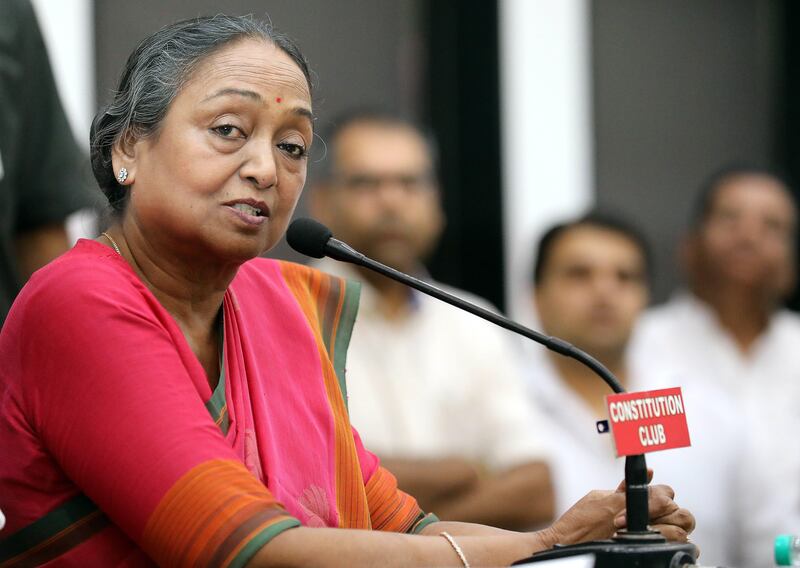CHENNAI // In India, the office of president is largely ceremonial, with five-yearly elections to the post usually an uncontentious business where the government and opposition settle on a consensus candidate. This year, however, the presidential election — in which national and state-level legislators vote — is shaping up to be a more heated affair.
Last month, Sonia Gandhi, the president of the Congress party, broke with convention and announced that the opposition was putting forward its own presidential candidate, former parliamentary speaker Meira Kumar. This presidential election, Ms Gandhi said, would be fought as “an ideological battle”.
The June 22 announcement came after prime minister Narendra Modi’s Bharatiya Janata Party (BJP) and its allies named Ram Nath Kovind, a lawyer and the governor of the eastern state of Bihar, as their presidential candidate.
“With his illustrious background in the legal arena … Kovind’s knowledge and understanding of the constitution will benefit the nation,” Mr Modi tweeted.
But despite such credentials, the prospect of a genuinely competitive election on July 17 has less to do with the viability of the candidates and more to do with the sharp polarisation between the BJP and the Congress, India’s main opposition party.
While the president is India’s head of state, real power rests largely with the prime minister and his government. The president’s only major role is to ensure that legislatures, at both a national and state level, act in accordance with the constitution.
Every presidential election throws up a host of candidates, ranging from maverick independents to nominees of regional parties. But typically, because of the president's largely ceremonial role, the biggest national parties settle on a consensus candidate who is agreeable to both the government and the opposition. In the case of all but one Indian president, this has resulted in the winning candidate easily securing more than 50 per cent of the vote. In 2002, for instance, APJ Abdul Kalam won 89.6 per cent of votes cast.
Only in 1969, thanks to a schism within the Congress party, did VV Giri edge out his closest rival by a slim margin.
No presidential election in recent memory has witnessed this year's level of acrimony — something that has sprung from the gaping ideological gap between the BJP and Congress and the subsequent clashes that have ensued between the two parties since Mr Modi became prime minister in 2014.
As the five-year term of the current president, Pranab Mukherjee, began drawing to a close earlier this month, speculation swirled about who the BJP would nominate and whether a consensus candidate would be found. But it was only when Congress nominated Ms Kumar that it became clear there would be no consensus between the two parties.
Pundits were confident the BJP would choose a candidate from the Dalit community, members of India's lower castes who have been traditionally marginalised but have gained political agency by virtue of their numbers. Roughly 17 per cent of Indians are Dalits.
As a result, the choice of Mr Kovind, whose caste is considered part of the Dalit community, is unsurprising.
“As evident in the recent Uttar Pradesh assembly polls, the BJP’s vote bank now comprises the upper castes and the Most Backward Class”, a state-defined demographic that receives government assistance, said D Shyam Babu, a senior fellow at the Centre for Policy Research in New Delhi who studies socioeconomic mobility among Dalits.
“So Kovind’s selection makes perfect sense.”
Dalits are frequently bracketed with the Most Backward Class demographic due to the extent of social ostracism and economic deprivation they've suffered.
The choice of Mr Kovind is particularly timely given that the new BJP government in Uttar Pradesh has been facing waves of protests by Dalits in response to the state’s crackdown on cattle slaughterhouses and attacks by vigilante gangs on cattle traders.
Dalits are among the most prominent employees of these trades, which other castes consider beneath them, and so have found themselves disadvantaged by the BJP’s national agenda to stop the slaughter of cows, which are venerated in Hinduism.
The Congress’ choice of Ms Kumar, who is also a Dalit, appears to be a direct response to the BJP’s move to make electoral decisions based on caste arithmetic.
Like Mr Kovind, Ms Kumar has a distinguished record of public service. Once a member of India’s diplomatic corps, she served in ministerial positions in Congress governments before becoming the first woman speaker of the Lok Sabha, the lower house of parliament.
But Ms Kumar's chances of victory are slim. The BJP’s numerical majority in the Lok Sabha as well as its success in state elections over the last three years will, in all likelihood, ensure Mr Kovind’s win, suggesting Ms Kumar's candidacy is little more than a statement of opposition to the BJP by Congress. Yet she is still fighting her corner.
"This is that moment when one should heed to the inner voice of conscience and set the course of the nation," she said last week.





